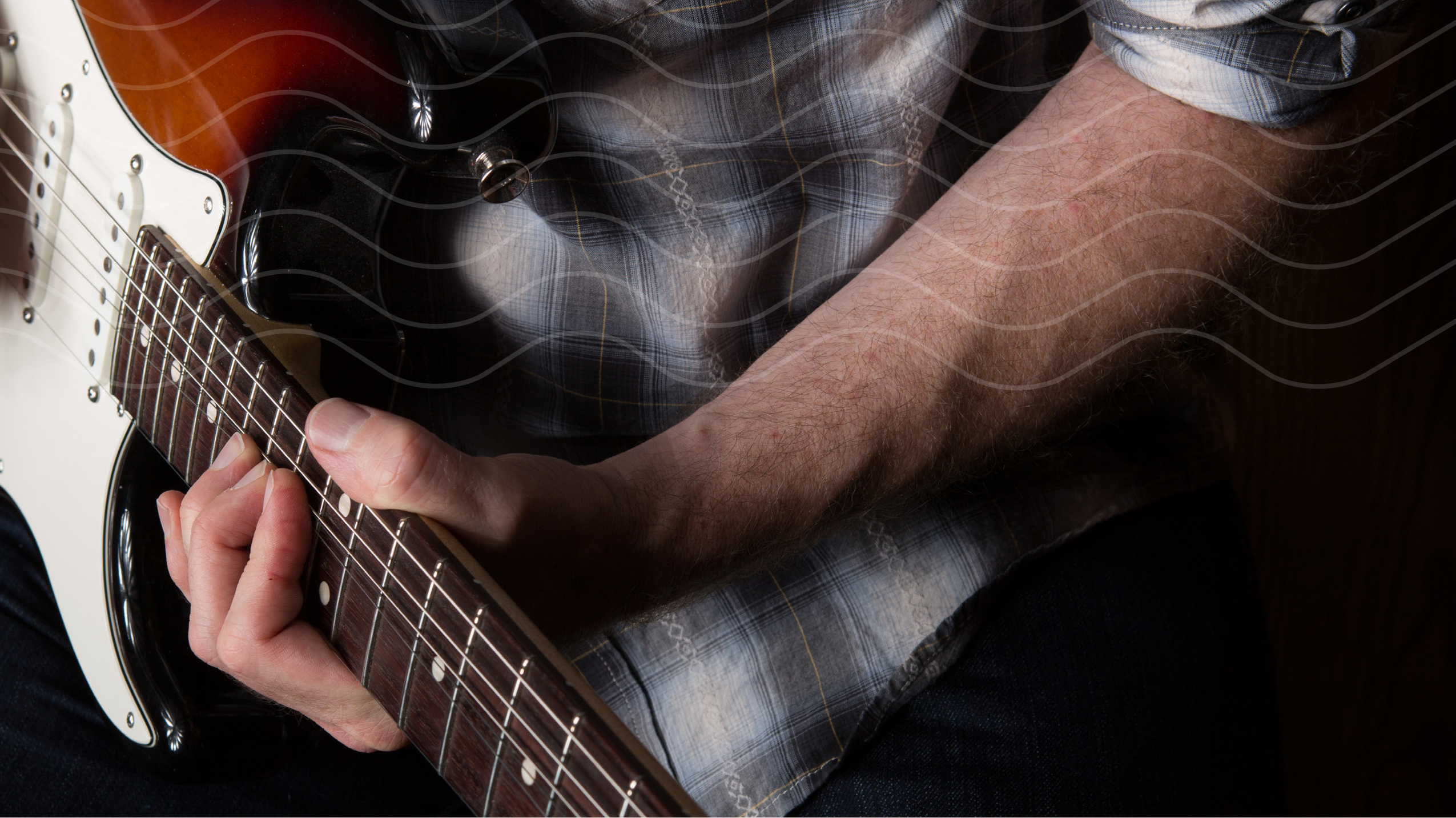![]()
One of the single most defining elements of any guitar player is their vibrato. As a teacher I find it to be one of the most overlooked techniques, which is unfortunate as it is one of the most important. Vibrato does many things from simply extending the duration of a note by the friction of the string on the fret, to expressing deep emotion and personality. It is also a very personal thing, what I might like in a vibrato, another guitar player may not. But we can all agree that it is something you must work on with intent just like scales. Vibrato must be in tune and in time. Good vibrato takes years to develop as it requires a fair amount of hand strength and a good ear. I have put together a few clips of some of my favorite players in live situations so you can listen and see how they approach vibrato. That to me was a huge part of the equation, no one ever taught me how to vibrato properly, I just started going to gigs, asking questions, buying instructional VHS tapes, and hanging with other players. This was all pre-YouTube, but MTV actually showed rock music videos at the time and I got to SEE how Stevie Ray, Clapton, Eddie, Gilmour and Yngwie would vibrato a note.
A strong vibrato starts with proper hand position, generally vibrato comes from the wrist and forearm. The fingers fretting the note are kept rigid, while the actual movement of the string comes from the wrist and forearm. Most players will pivot on the knuckle of the first finger to anchor the hand. The thumb comes over the top of the neck to add leverage, which is especially important when adding vibrato to a bent note. I am talking about blues and rock guitar vibrato, the kind of guitar I play. Classical guitar vibrato is a different technique that is also definitely worth exploring, but nylon strings are very different. Many players believe that the thumb should not come over the neck and vibrato and bends should come only from the fingers, I am not one of them! This is very often dependent on string gauge and other factors. I played that way when I was younger and it led to hand problems that all but went away when I changed to the technique I am using now. This is the technique you will see in the following clips as well, so play close attention!
This first clip is from the rather dated “Farewell To Cream” concert film. Apart from Clapton coming off a bit Spinal Tap-ish and some odd narration, Eric provides us a wealth of information into how he got his sound, bending strings, and his vibrato up close. Notice his vibrato is all coming from his wrist and forearm, not his fingers. His fingers are more or less locked in place and the work is from the forearm/wrist motion. He can be very subtle or extremely aggressive with his all in one phrase. I love how he even addresses the topic directly. The super bonus from this clip was how it taught me to get the most out of a Gibson tonally.
Another master of vibrato and huge influence on me, and millions of other guitar players, is David Gilmour. As a kid I was a Pink Floyd fanatic, and still hold Gilmour’s playing as a high benchmark. Although all of his solos left an impression on me, none did more for my vibrato, and understanding of control, as the “Shine On You Crazy Diamond” solos. If you notice his vibrato is a mix of both standard left-hand technique and the vibrato bar. Sometimes he does one or the other, or both at the same time. This solo also showed me how vibrato can add a vocal quality to the guitar. Notice how a great singer will choose their vibrato carefully depending on what emotion they are trying to express at that time. Here, Gilmour does just that, some vibrato is faster, slower, wider, smaller, delayed, etc. All very vocal. I highly suggest, if you are a fan, learning the solos from the original recording, they were an eye opener for me. An important note is that Gilmour’s bridge is floating, this allows him to move the pitch both above and below the note when he uses the bar.
We just saw how David Gilmour’s vibrato added a huge vocal component to his playing, I think nobody does it better than Jeff Beck as we can see in the following clip of him performing Puccini’s “Nessun Dorma.” To get a point of reference (the highest point of reference possible), let’s listen to Luciano Pavarotti’s 1980 performance from Lincoln Center. If this doesn’t move you, I’m not sure what will!
Now watch how Beck evokes the human voice through his use of bends, dynamics, phrasing, and of course vibrato. I think this is particularly striking hearing it next to Pavarotti.
As we can see Beck’s control is outstanding and unlike any other player. He uses a mixture of bends, dynamics, and of course, vibrato to capture the sound of the human voice. In that performance we see that Beck’s vibrato mainly comes from the bar. His is also floating, so much so that he can pull up a major 3rd on the G string. Although this isn’t traditional hand vibrato, the effect is still the same. He plays equally as well with a traditional approach.

Vibrato can be much more aggressive than the players we have looked at so far, yet just as beautiful. One player who made me see this was Yngwie Malmsteen, I know you mainly know me as a blues guy, but I love metal and hard rock as well. I was a teenager when Yngwie first hit the scene and he changed everything for me as a player. I saw him with Alcatrazz on the same tour (video below). I was in the front row watching a guy a few years older than me play like I have never seen anyone play before. I still love his playing especially from this period. Yes, it may be gratuitous, but hey, it’s metal in 1984 and he had something to prove. Clearly he is known for his chops, which are amazing, but his vibrato is just as impressive. It is wide and fast and aggressive on the rocking numbers while controlled and slow on the the slower sections. Once again we see he is using a traditional approach to his vibrato, it comes from his wrist, fingers locked, thumb over the top of the neck, pivoting on the knuckle of the first finger. Let’s take a look. Wow, I just realized this was 30 years ago…
I could post videos all day of great players and their vibrato because it is one of the things that makes them great players. These are just a few players who influenced me. Others that came to mind are Peter Green, Van Halen, Albert King, Eric Johnson, Robin Trower, Jimi Hendrix, Daniel Lanois, and more, it is a very long list! What I wanted you to see is that all of these players have great control over the guitar and that can only come with practice solely focused on vibrato. The best way to practice the technique is to play a note, start with a G in the 12th fret of the 3rd string. Play the note and listen to the pitch, now add some vibrato. Is it in tune? The common mistake people make at first is to let the vibrato go sharp by not allowing the string to return to pitch. Think of it as releasing the tension in your hand and letting the note come back to pitch itself. The vibrato should only be in one direction, pull the string up or down on either side of the center point. It is important not to do both as it actually cancels out the vibrato for the most part. Obviously if you are playing on the high E string, you can only vibrato upwards or you will pull the string off the neck. Other than the high and low strings, there is no rule as to what direction you must vibrato.
Next you want to decide on what kind of vibrato you want; how wide and how fast or slow will be. This is where personal preference really comes into play as there is no right or wrong. My default vibrato is similar to David Gilmour’s or Eric Clapton’s, a smooth medium speed, a little on the wider side. BB King’s vibrato is small and fast, whereas Zakk Wylde’s is huge and fast. Like I said, this is up to you, but whatever it is, it should be a conscious decision. It should be in tune, and consistent. I cannot stress enough the importance of experimenting with all different kinds of vibrato as they all add a different flavors and emotions to your playing. I also suggest doing what everyone before us did, listen and transcribe some of your favorite players. Learn the solos note for note, and try to match every nuance as best as you can. Find a player who’s playing you love and analyze and reproduce their vibrato. Go on YouTube, or better yet see them live is possible, watch and listen, then practice! Here’s a quick little check list of things to think about when working on your vibrato:

Learn from Jeff McErlain at TrueFire>>






